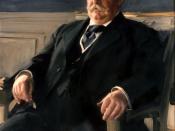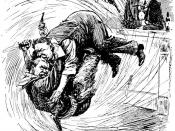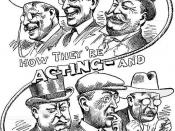The United States presidential election of 1912 was contested between four candidates; Incumbent Republican William Howard Taft, Woodrow Wilson a democrat, former President Theodore Roosevelt running for the new Progressive Party, and Eugene V. Debs who was running for President under the Socialist Party for the fourth time. Roosevelt, a former Republican, declined to run for reelection in 1908, following the long-established tradition that Presidents were to leave office after two terms. He instead hand-picked William Howard Taft to succeed him and Taft eventually won the election of 1908. During Taft's presidency, a rift grew between the two because Taft pulled away from Roosevelt's idea of state-administered capitalism. The Republican Party became divided and Roosevelt led the progressives while Taft became identified with the conservatives. Both Taft and Roosevelt vied for the Republican Party's presidential nomination, with Taft eventually winning the party's nomination. Republican progressives reconvened in Chicago and endorsed the formation of a national progressive party nominating Roosevelt as their presidential candidate.
The nomination for Democratic Party was extremely competitive. After a long deadlock Democratic candidate William Jennings Bryan threw his support behind Woodrow Wilson in order to defeat Missouri Representative Champ Clark. Woodrow Wilson, former President of Princeton University and Governor of New Jersey, won the Democratic nomination after support for Clark faded. The Socialist Party of Americahttp://en.wikipedia.org/wiki/Socialist_Party_of_America was a highly factionalized coalition of local parties based in industrial cities and usually was rooted in ethnic communities, especially German and Finnish. By 1912, the party claimed more than a thousand locally elected officials in 33 states and 160 cities, especially in the Midwest. The leader of the Socialist Party, Eugene V. Debs had already ran for President in 1900, 1904, and 1908, primarily to encourage the local effort, and he decided to do so again in 1912.


